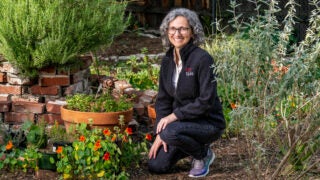USC Price professor reports on L.A. Promise Zone efforts at White House workshop
Gary Painter covers the federal program addressing challenges in areas with persistent poverty
USC Price School of Public Policy Professor Gary Painter took part in a recent White House workshop exploring university engagement in Promise Zones.
The term refers to a federal program, established by the Obama Administration, aimed at addressing challenges in geographic areas of deep and persistent poverty. There currently are 22 high-poverty urban, rural and tribal communities designated as Promise Zones, including two areas within the city of Los Angeles.
For the two L.A. Promise Zones, the Sol Price Center for Social Innovation (CSI) is serving as the lead research and evaluation partner, charged with gathering and analyzing data to measure the initiative’s outcomes over 10 years.
“When you think about the mission of the university, our work with the Promise Zones is just a tremendous example of the kind of partnership that can happen,” said Painter, the director of social policy at Price CSI. “It’s always beneficial when you get a chance to share and learn how different people are organizing themselves to achieve a common objective.”
Measuring change
At the Sept. 23 workshop in Washington, D.C., Painter delivered a talk and facilitated a breakout session on research and evaluation with Alison Becker, the director of the Promise Zone initiative in the Los Angeles Mayor’s Office.
The city’s first Promise Zone encompasses areas in Pico-Union, Westlake, Koreatown, East Hollywood and Hollywood, and has received more than $100 million in grants since its designation in 2014.
Newly designated in 2016, the city’s second Promise Zone covers parts of Vernon-Central, South Park, Florence, Exposition Park, Vermont Square, Leimert Park and Baldwin Hills/Crenshaw — and also includes the University Park Campus. The area has been dubbed the “South Los Angeles Transit Empowerment Zone,” or SLATE-Z, because of the opportunities for neighborhood revitalization, education and economic advancement brought by the new Expo light rail line.
Painter shared his experiences in helping develop comprehensive evaluation plans, with metrics to measure community change in the Promise Zones.
To provide data and reports for the Los Angeles Promise Zones and other communities, Price CSI is also developing a web platform called “Neighborhood Data for Social Change,” which will launch in spring 2017.
“We really needed to develop a neighborhood data platform for all of Los Angeles; it’s going to be county-wide,” Painter explained. “We’re really excited about that, providing more than 100 data series across policy domains and issue areas. Communities can geographically define their boundaries and get all of these data, whether it’s about education, the environment, public safety, economics or demographics, among other social indicators.”
Commitment to the community
Painter also discussed how the university has not only partnered with nonprofits on specific grant applications for the Promise Zones, but has made an ongoing commitment to the communities.
You can’t just sit in an ivory tower.
Gary Painter
“You can’t just sit in an ivory tower,” Painter said, “and when you’re going to have a special grant application, then you pop in. You actually have to be embedded in the community. It’s been tremendously rewarding to be part of that process and to be part of the community.”
For Painter, the workshop underscored the importance of USC Price’s role in creating far-reaching and sustainable vitality not just in the Promise Zones, but also in other low-income, urban communities across Southern California.
“What I saw is that cities and these collective impact initiatives really desire greatly to have partnerships with the universities,” said Painter. “It certainly made us feel like we’re doing something that is valuable.”



